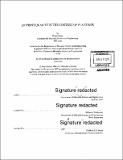| dc.contributor.advisor | Michael J Tarkanian. | en_US |
| dc.contributor.author | Sears, Forest (Forest Orion) | en_US |
| dc.contributor.other | Massachusetts Institute of Technology. Department of Materials Science and Engineering. | en_US |
| dc.date.accessioned | 2016-09-13T19:25:11Z | |
| dc.date.available | 2016-09-13T19:25:11Z | |
| dc.date.copyright | 2016 | en_US |
| dc.date.issued | 2016 | en_US |
| dc.identifier.uri | http://hdl.handle.net/1721.1/104320 | |
| dc.description | Thesis: S.B., Massachusetts Institute of Technology, Department of Materials Science and Engineering, 2016. | en_US |
| dc.description | Cataloged from PDF version of thesis. | en_US |
| dc.description | Includes bibliographical references (page 45). | en_US |
| dc.description.abstract | 3D printing is a hot topic in manufacturing and a truly useful tool, but it has limitations. Print quality properties - like raft peelability, dimensional tolerance and surface roughness - are hard to calibrate perfectly. A common material used in fused deposition modeling (FDM) printers is polylactic acid (PLA). One print quality concern is how different colors of PLA print differently under the exact same settings. The inconsistency in print quality by color is bad for designers, students, and engineers who want to rapidly prototype effectively. Analyzing the thermal, chemical and mechanical properties of the different colors of PLA and relating it to the quality of the prints gives the user a chance to calibrate their machine effectively for higher quality prints. The quality of prints are quantified by scoring systems that measure three properties of a print: dimensional tolerance, how easily the raft peels from the print, and the surface roughness. The thermal properties of the different colors of PLA were analyzed using differential scanning calorimetry (DSC) up to 230° C. The integrals of peaks and troughs from the DSC - representing heat absorbed and released by the different colors of PLA - show that each color responds differently to thermal treatment. The mechanical strength of each color was found to be different through uniaxial tensile testing. Yellow and orange filament had high percent crystallinity at -12.1%, while having a high yield stress at 41-45 MPa, and a low yield strain at 6.6%-11% extension. Red and blue filament had low percent crystallinity at ~8.8-10.2%, while having a low yield stress at 33-36 MPa, and a high yield strain at 18%-23% extension. Additionally, Fourier transform infrared spectroscopy (FTIR) analysis determined each PLA color had unique additives. For calibrating printers for reliably high quality prints, crystallinity has a relationship with the amount of material extruded which could factor into qualities like dimensional tolerance and surface finish. | en_US |
| dc.description.statementofresponsibility | by Forest Sears. | en_US |
| dc.format.extent | 60 pages | en_US |
| dc.language.iso | eng | en_US |
| dc.publisher | Massachusetts Institute of Technology | en_US |
| dc.rights | M.I.T. theses are protected by copyright. They may be viewed from this source for any purpose, but reproduction or distribution in any format is prohibited without written permission. See provided URL for inquiries about permission. | en_US |
| dc.rights.uri | http://dspace.mit.edu/handle/1721.1/7582 | en_US |
| dc.subject | Materials Science and Engineering. | en_US |
| dc.title | 3D print quality in the context of PLA color | en_US |
| dc.title.alternative | 3-dimensional print quality in the context of PLA color | en_US |
| dc.title.alternative | Three-dimensional print quality in the context of polylactic acid color | en_US |
| dc.type | Thesis | en_US |
| dc.description.degree | S.B. | en_US |
| dc.contributor.department | Massachusetts Institute of Technology. Department of Materials Science and Engineering | |
| dc.identifier.oclc | 958279250 | en_US |

